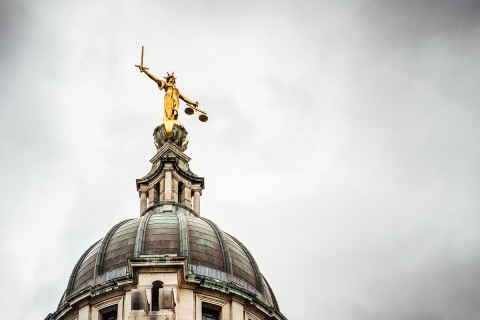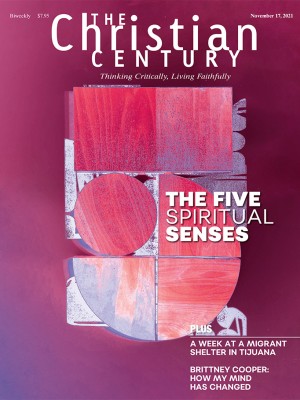Pure justice is an idol
Atop the Central Criminal Court of England and Wales, Lady Justice presides over a long history of injustices.

The Central Criminal Court of England and Wales, known as the Old Bailey after the street on which it stands, is the most famous court in Britain. It’s now a sprawling complex incorporating several courtrooms. Tucked away on a wall near an old entrance is a plaque commemorating an event that took place in 1670.
William Penn was a busy man before he came to America and gave his name to Pennsylvania. He was a leader of the Quakers. At the time they were regarded as an illegal sect, unwilling to cooperate with the established church. Hence they couldn’t meet in any house of worship—so Penn led a worship service for a handful of people on a quiet street. He and a colleague, William Mead, were arrested for taking part in an unlawful and tumultuous assembly.
Read our latest issue or browse back issues.
At their trial, Penn demanded to know on what law he was being indicted. “For where there is no law, there is no transgression,” he said, “and that law which is not in being, is so far from being common, that it is no law at all.” When the judge demurred, saying it took 30 or 40 years to study the common law, Penn added, “If the common law be so hard to understand, it is far from being common.”
The judge was furious with Penn and instructed the jury to find the defendants guilty. The jury pronounced them not guilty. So the judge sent them away to consider a different verdict. When they returned the same verdict, the judge demanded from Edward Bushell, the jury’s spokesman, “a verdict that the court will accept, and you shall be locked up without meat, drink, fire, and tobacco. . . . We will have a verdict, by the help of God, or you will starve for it.” The rigmarole was repeated three further times, after which the jury refused to go out for a sixth time. The judge fined them and imprisoned Penn and Mead for contempt of court. Eventually a writ of habeas corpus gained release for all involved.
The jurors sued the mayor and judge and won. It was concluded that judges “may try to open the eyes of the jurors, but not lead them by the nose.” Sometimes known as Bushell’s Case, it became a landmark moment in the history of British justice. Thereafter juries would have the right to give their verdict according to their convictions.
On top of the dome above the Old Bailey stands a bronze statue of Lady Justice, scales in her right hand and a sword in her left. Personifying justice in this way enhances the notion that justice is an absolute—that it can be arrived at definitively and, once achieved, that all other virtues and blessings will follow. Movements for social justice, while they’ve largely moved on from bronze statues, tend to the same view: justice is an abstract goal that, once attained, yields all other goods.
The Bushell case suggests to me, rather, that justice is not an abstract goal. It is instead a set of conventions, arrived at through earnest striving for good order and universal well-being. Pure justice is an idol; there’s very little that’s pure about human relations gone so badly wrong as to involve the courts. Establishing good conventions is the heart of justice, and those conventions, far from being luminous and eternal, are always in need of updating and refining. Justice is a system, not an ideal; a best attempt, not perfection.
The problem with looking into the sky to see the bronze Lady Justice is not just that hopes dashed in pursuing abstract ideals waste energy that could be spent developing better conventions. It’s that an incarnate faith looks down to the ground at least as much as up to the sky. In the basement of the Old Bailey lie the tiny, windowless cells in which prisoners awaiting trial are kept. Depriving people of their liberty, and in many cases keeping them in tortuously confined spaces for long periods, isn’t pure justice; it’s a convention—one that shames our societies. Much attention is given, rightly, to the disproportionate balance of who comes to be incarcerated, and to the way the prison population reflects the inequalities of our societies more generally. But too little attention is spent on the nature and purpose of incarceration itself.
In its early days, the Old Bailey dispensed summary justice. Punishments such as whipping, branding, and the pillory or stocks dealt with crimes instantly. Today we decry such things as inhuman and degrading. But why do we not feel the same about locking a person up for years on end? And how do we tolerate the extended periods for which the accused can be kept in such conditions before a conviction that may never come?
John Wesley encouraged his followers to go not just where they were needed but where they were most needed. I have no reason to discourage Christians from campaigning for a more equal spread of opportunity, wealth, and freedom from police violence—but some issues are perpetually overlooked. If we recognize that justice is a convention, then we’ll more readily realize that some conventions are well overdue for a wholesale review. While incarceration for public protection still has a role, its use as retribution or deterrent is outdated, expensive, counterproductive, and a source of shame for society. Is prison today a dimension of the justice system, or is it a form of the institutionalization of injustice? Christians are supposed to be in the transformation, regeneration, and rehabilitation business. It’s time we looked at our penitentiaries and recognized how poorly they advance those goals.






